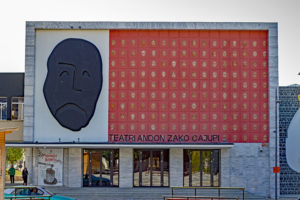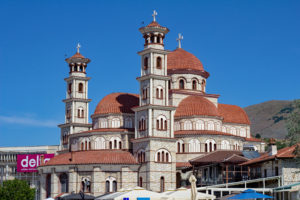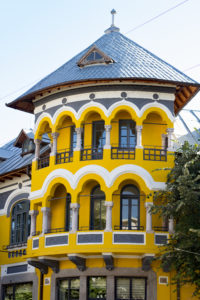We stayed in Korça, south east Albania for three nights. Before checking into the “Bujtina Sidheri”:https://www.silvertraveladvisor.com/review/accommodation/200646-review-bujtina-sidheri, we began our sightseeing with:
Meadow of Tears – a grassy area, just on the edge of town, which was the spot where in the 19th and 20th centuries families would wave goodbye to their emigrant menfolk. Now it contains a huge row of modern statues, which were apparently the entrants in a sculpture competition (we later saw the winning sculptures outside the Municipality Building).
Martyrs’ Cemetery – perched high on a hill overlooking the town. There was a huge statue of a soldier, arm held aloft, surrounded by numerous graves built into the sides, all from either 1911 or 1944.
On our official half-day sightseeing tour, we began at:
Iljaz bej Mirahori Mosque – said to be the oldest mosque in the Balkans having been erected in 1496. An earthquake in 1960 damaged the original minaret and clock tower, the latter having been rebuilt only five years ago. Inside were frescoes of Mecca and Medina and above the altar, the Blue Mosque in Istanbul. They’d all been renovated, as they’d been whitewashed during the communist period. The mosque had been declared a cultural monument and therefore, unlike many religious buildings, had not been damaged. I was invited to go up the minaret to the woman’s balcony and whilst I’ve visited many mosques, this was a new experience and I was surprised how incredibly narrow and steep the twelve stairs were.
Bazaar – the buildings, many with balconies, date back to the 18th century and would have originally been separated into areas for wool, cheese and women (not where women were traded, but where the women traded). There have been three fires since, mainly due to the amount of wood used in their construction. Many of the buildings, around the narrow-cobbled streets, were closed and we were told this is because the Government only want bars, restaurants or antique shops, so owners wanting to sell other goods, are refusing to open. A ‘misunderstanding’ with the government has resulted in a brown three storey building with wrought iron balcony, originally the home of a wealthy merchant, simply been left. This was such a shame for a beautiful building.
We returned to the bazaar in the evening to visit the characterful bars and restaurants with their outside tables and chairs. Kafe Komiteti, was more like a museum from the communist era with a loo which our guidebook said looked like a raki still. We thought it resembled a butternut squash. Kafe Kooperativa served us two glasses of wee-coloured, luke-warm white wine and charged 100 Lek more than Kafe Komiteti. Whilst the Beatles Bar, had uncomfortable coloured chairs and tables and staff, busy on their mobiles, who appeared to think customers were a nuisance.
Andon Zako Çajupi Theatre – had been built during the communist era and reconstructed two years ago. The outside was decorated with individual facial masks, but all designed by the same person. It’s named after a writer, Andon Zako Çajupi, and seats around 300 to 400 with tickets costing a realistic €3 to €5.
Panorama tower – is a viewing tower built about 7 years ago at great cost. For this reason, it’s unpopular with locals who consider the views from the Martyrs’ Cemetery are as good. Its location in what is known as ‘Theatre Square’, means it obliterates views of the theatre. It’s a rather ugly building and known locally as the ‘toothbrush tower’.
The Resurrection of Christ Orthodox Cathedral – built in 1995 on the site of a previous church destroyed by the communists in 1968. As Mass had just finished, we were able to go in and see the paintings on the walls of the saints: males on the right and females on the left. Floor mosaics apparently act as a calendar with the light shining through the windows.
Boulevard Shen Gjergji – is one of the main pedestrianised streets, and one we’d walked down the previous day. But our guide’s insight into the eclectic buildings was fascinating and the most interesting were:
A ‘virtual church’ had the original footprint of a church destroyed by the communists marked out on the pavement. Stones were said to have been taken from the church to build an unused tennis court. Part of the footprint is now a library and when it was being built, the government disliked the design and the architect was sentenced to prison for one year: this was deemed to be a light sentence.
A striking yellow painted building known as the Romanian House but actually the Gjon Mili Museum of Photography. Inside we looked around the exhibition of photos of many famous people, including Picasso, and we could have spent longer learning about Mili’s technique using stroboscopic light.
Grey concrete apartment blocks built during the communist era.
The first Albanian school built in 1887 when only Ottoman schools or separate girls’ schools were allowed – this was a mixed school. It is now the Museum of Education but was closed as it had been affected by an earthquake earlier in June 2019.
Brewery – Korça beer is ubiquitous in Albania and although the brewery has tours, unfortunately we didn’t have time in our itinerary.
Korça has clearly been impacted by the communist regime and today’s Government still seem to be creating problems for what we found to be an interesting town.










